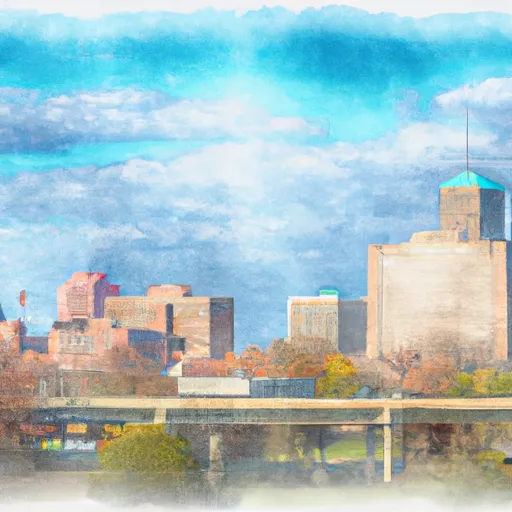-
 Snoflo Premium
Snoflo Premium
Get unlimited access to all our content
With no Ad interruptions! - Start Your Free Trial Login with existing account
South-Bend
Eden Index
Climate
8.0
•
Recreation
4.5
•
Community
2.3
•
Safeguard
5.3/10

South Bend, Indiana is a vibrant city located in St. Joseph County, in the northern part of the state. The climate in South Bend is classified as humid continental, characterized by warm summers and cold winters. Average temperatures range from 18°F (-8°C) in winter to 82°F (28°C) in summer.
Hydrologically, South Bend is situated near the St. Joseph River, which flows through the city, providing scenic beauty and recreational opportunities. The river is popular for activities like fishing, canoeing, and kayaking, allowing visitors to enjoy the natural surroundings.
In terms of outdoor recreation, South Bend offers a range of opportunities. The city has several parks, including the popular Potawatomi Park, which features beautiful gardens, picnic areas, and a zoo. Nearby, residents and visitors can explore the East Race Waterway, where whitewater rafting and kayaking are available.
For nature enthusiasts, the nearby Indiana Dunes National Park offers stunning sand dunes, hiking trails, and bird-watching opportunities along Lake Michigan. Additionally, South Bend is home to numerous golf courses, providing options for golf enthusiasts.
Overall, South Bend's climate, proximity to waterways, and diverse outdoor recreation opportunities make it an attractive destination for those seeking to enjoy nature and engage in various recreational activities.
What is the Eden Index?
The Snoflo Eden Index serves as a comprehensive rating system for regions, evaluating their desirability through a holistic assessment of climate health, outdoor recreation opportunities, and natural disaster risk, acknowledging the profound impact of these factors on livability and well-being.
Climate Health Indicator (CHI): 8.0
South-Bend receives approximately
1008mm of rain per year,
with humidity levels near 81%
and air temperatures averaging around
10°C.
South-Bend has a plant hardyness factor of
6, meaning
plants and agriculture in this region thrive during a short period during spring and early summer. Most
plants will die off during the colder winter months.
By considering the ideal temperature range, reliable water supplies, clean air, and stable seasonal rain or snowpacks, the Climate Health Indicator (CHI) underscores the significance of a healthy climate as the foundation for quality living.
A healthy climate is paramount for ensuring a high quality of life and livability in a region, fostering both physical well-being and environmental harmony. This can be characterized by ideal temperatures, reliable access to water supplies, clean air, and consistent seasonal rain or snowpacks.
Weather Forecast
Streamflow Conditions
Southeastern Lake Michigan
Area Rivers
Southeastern Lake Michigan
Snowpack Depths
Southeastern Lake Michigan
Reservoir Storage Capacity
Southeastern Lake Michigan
Groundwater Levels
Recreational Opportunity Index (ROI): 4.5
The Recreational Opportunity Index (ROI) recognizes the value of outdoor recreational options, such as parks, hiking trails, camping sites, and fishing spots, while acknowledging that climate plays a pivotal role in ensuring the comfort and consistency of these experiences.
Access to outdoor recreational opportunities, encompassing activities such as parks, hiking, camping, and fishing, is crucial for overall well-being, and the climate plays a pivotal role in enabling and enhancing these experiences, ensuring that individuals can engage in nature-based activities comfortably and consistently.
Camping Areas
| Campground | Campsites | Reservations | Toilets | Showers | Elevation |
|---|---|---|---|---|---|
| Spring Mill State Park | 220 | 670 ft | |||
| Hardin Ridge | 200 | 780 ft | |||
| Morgan - Monroe State Forest | 30 | 941 ft | |||
| Mason Ridge - Morgan Monroe State Forest | 30 | 707 ft | |||
| Starve Hollow State Rec Area | 200 | 552 ft | |||
| Delaney Creek Park | None | 584 ft | |||
| Brown County State Park | 430 | 899 ft | |||
| Yellowwood State Forest | 80 | 613 ft | |||
| Buffalo Trace Co Park | 64 | 803 ft | |||
| Paynetown State Rec Area - Monroe Lake | 320 | 557 ft |
Nearby Ski Areas
Catastrophe Safeguard Index (CSI):
The Catastrophe Safeguard Index (CSI) recognizes that natural disaster risk, encompassing floods, fires, hurricanes, and tornadoes, can drastically affect safety and the overall appeal of an area.
The level of natural disaster risk in a region significantly affects safety and the overall livability, with climate change amplifying these risks by potentially increasing the frequency and intensity of events like floods, fires, hurricanes, and tornadoes, thereby posing substantial challenges to community resilience and well-being.
Community Resilience Indicator (CRI): 2.3
The Community Resilience Indicator (CRI) recognizes that education, healthcare, and socioeconomics are crucial to the well-being of a region. The CRI acknowledges the profound impact of these elements on residents' overall quality of life. By evaluating educational resources, healthcare accessibility, and economic inclusivity, the index captures the essential aspects that contribute to a thriving community, fostering resident satisfaction, equity, and social cohesion.

